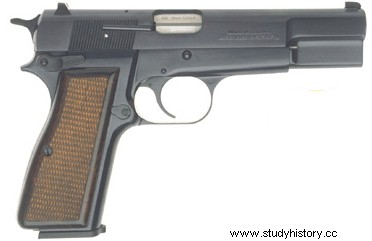
Mark III
* Ammunition:9mm Parabellum (existing versions in 7.65 Parabellum and .40 S&W)
* Length:20cm
* Barrel length:11.8cm
* Unladen weight:0.810kg
* Loaded weight:0.986kg
* Magazine capacity:13 or 20 (9mm Parabellum), 10 (.40 S&W)
The Browning Hi-Power (also called Browning GP 35 and Browning HP 35, commonly abbreviated as Hi-Power) is the last pistol partly developed by John Moses Browning. Indeed, the Hi-Power results from the improvement of a patent of the American John Moses Browning deposited in 1925, itself resulting from an improvement of the patent of 1897. However, Browning dying in 1926, it will be necessary to wait a number of modifications and almost a decade before the Hi-Power was produced by the Belgian company FN Herstal from 1935, as the Browning GP 35 (for Great Power - year 1935) (Browning was linked to the Belgian firm for the exploitation of its patents in Europe since the production of the Browning M1900). A semi-automatic pistol operating in single action, the GP 35 was originally available with two types of sights, one fixed and one adjustable from 50 to 500 m, and the handle could be fitted to attach a detachable stock (which served also a case). Generally, pistols with a fixed rise had a classic grip, and those with an adjustable rise had a detachable butt. The weapon will be purchased by the Belgian army and the Belgian police shortly before the Second World War.
During World War II, the Browning Hi-Power will probably be the only weapon that will be made by both sides. Indeed, the German army will use (under the name of P35 (b), for pistol, year 1935, manufactured in Belgium) Hi-Power manufactured in the factory of FN Herstal (it seems besides that the Belgian workmen deliberately misworked, and that the P35(b)s produced during the occupation were unreliable), while the John Inglis factory in Toronto will build the Hi-Power for the allies from plans that may have been evacuated before the invasion of Belgium. Called HP 35 (for High Power - 1935) by the manufacturer, it will arm the Canadian and Chinese armies, and many British officers will acquire it as a secondary weapon in addition to their regulation Enfield .38 revolvers.
After the war, the Browning HP was adopted by a large number of armies and police forces, in particular by becoming the first regulation pistol of the British army (called L9A1) to replace the .38 caliber revolvers, of which it is still the service handgun. Among its most illustrious users are the British Special Air Service and the FBI Hostage Rescue Team. In the 1960s and 1970s, the Belgian firm granted a manufacturing license to Indonesia (Pindad P1A 9mm) and Argentina (FM Browning). The Argentine model, replacing the FMAP 1927 (Colt M1911) in the armed forces and the police, quickly found itself in the hands of many South American drug traffickers. The FM Browning was offered in the commercial circuit by the private firm Bersa (Bersa 90). The Hungarian FEG 9, the Bulgarian Arcus are other copies.
Chambered in 9mm Parabellum, the capacity of 13 shots of the double column magazine was a definite advantage for a weapon of the time. An extended 20-round magazine was also produced (used by intervention units such as the British SAS). The Browning Hi-Power was also chambered in 7.65mm Parabellum (in the 1970s for Italy) and .40 S&W for the North American market primarily (Mark III model, see below).
The Hi-Power has undergone a certain number of improvements, in particular in the 1980s with versions with double action locks (DA/SA or DAO), under various designations:Browning HP-DA, BDA9 and BDAO (see Browning HP-DA). These, however, met with little success. More recently, versions intended for the military/police market have been launched, the Mark II, then the Mark III still currently offered (in the USA, it is called HP-SA for single-action, as opposed to the Browning HP-DA). The Mark III is equipped with a firing pin safety, more modern sights and plastic buttplates, and it can be chambered in .40 S&W. An improvement of its single action frame gave birth to the HP SPS (Self Fast Shooting).
The mechanism of this weapon has been and continues to be fully or partially taken over in an impressive number of pistols. Reliable, functional and high capacity, the Browning Hi-Power is, after the Colt M1911, the second oldest pistol still in service, and should probably be, after the American model, the second pistol to have exceeded a century. on duty. It is still in service in the 21st century with the Belgian army and police, the British army and various military and police services.
